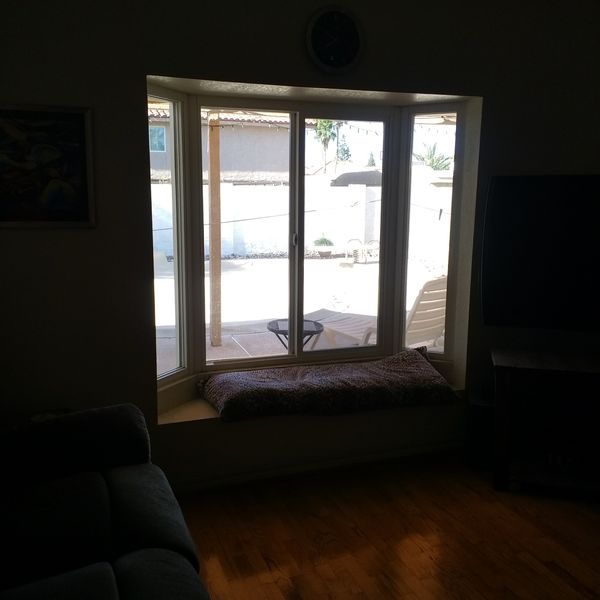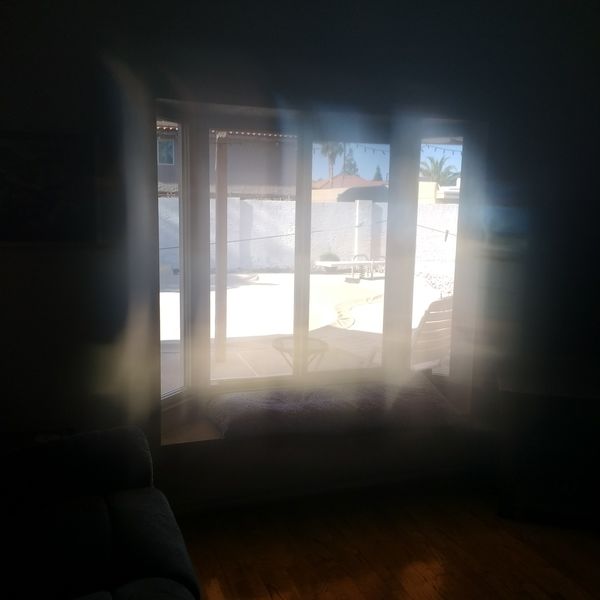Too much backlight
Jun 2, 2018 16:13:27 #
Hi! My name is Mark. I've been a photography enthusiast for over 30 years. Smartphones haven't been out that long, and I started with film based cameras. I've taken some pretty good shots with those type of cameras. When digital cameras came out, I had a new toy that I had to try out. I'm still getting used to it even after 20 years. One problem I've always been faced with, no matter the camera type, is too much light in the background. I learned how to use manual settings with a FinePix s700 and have taken a few good pictures with bright backgrounds.
It seems the smartphone takes a good selfie because the auto light sensor is on the front side of the phone. But if you're indoors and want to take a picture of someone coming in through your front door at noon, the lens on the back of your camera says it's daylight and the sensor on the face of your camera says it's dark. The finished product is similar to the ET scene where the mother ship lands and a silhouette walks down the steps in the drop hatch.
If I change position in the room, allowing the subject to enter the room before I take the picture, it's not the same shot! Can someone help me with this please? I'm good with manual controls, but I can't seem to find those on my smartphone... LOL!
It seems the smartphone takes a good selfie because the auto light sensor is on the front side of the phone. But if you're indoors and want to take a picture of someone coming in through your front door at noon, the lens on the back of your camera says it's daylight and the sensor on the face of your camera says it's dark. The finished product is similar to the ET scene where the mother ship lands and a silhouette walks down the steps in the drop hatch.
If I change position in the room, allowing the subject to enter the room before I take the picture, it's not the same shot! Can someone help me with this please? I'm good with manual controls, but I can't seem to find those on my smartphone... LOL!
Taken using manual settings on the s700

Taken in the same lighting conditions with my LG K20

Jun 2, 2018 16:19:24 #
Welcome pentewiz! The solution to your problem is called 'fill flash'. Activate the flash in situations like the second image and you'll be on your way to a better result, which seems to be what worked on the first image.
Jun 2, 2018 16:35:47 #
CHG_CANON wrote:
Welcome pentewiz! The solution to your problem is called 'fill flash'. Activate the flash in situations like the second image and you'll be on your way to a better result, which seems to be what worked on the first image.
Actually, I used fill flash on the second one as indicated by the dark feet. The first photo was taken using manual aperture and shutter settings on my S700.
Jun 2, 2018 17:10:16 #
Mark, Welcome to the forum. When I look at the second image, I see windows that is causing the effect you see. Have the subject turn 180 degrees so your back is to the windows and you will have a great image.
Jun 2, 2018 18:40:26 #
Jun 3, 2018 03:57:08 #
If your camera or phone can't do exposure bracketing it may have a HDR mode.
#2 is suffering from what looks like a diffuse form of lens flare, probably caused by large amounts of stray light bouncing around inside the lens. That's a possibility every time you point the camera in the same direction as a bright light source, and especially when the light source is directly in front of the camera. In those situations you'd probably find that HDR and even exposure bracketing will provide a partial answer at best.
#2 is suffering from what looks like a diffuse form of lens flare, probably caused by large amounts of stray light bouncing around inside the lens. That's a possibility every time you point the camera in the same direction as a bright light source, and especially when the light source is directly in front of the camera. In those situations you'd probably find that HDR and even exposure bracketing will provide a partial answer at best.
Jun 3, 2018 10:39:26 #
A smartphone doesn't have a strong enough flash to fill a backlit subject like this. You can try, and it might improve it, but it's likely not powerful enough. Best to know the limitations of your camera/phone and simply place your subject in a better light.
pentewiz wrote:
Hi! My name is Mark. I've been a photography enthu... (show quote)
Jun 3, 2018 10:56:57 #
pentewiz wrote:
Hi! My name is Mark. I've been a photography enthu... (show quote)
My take on the phone/camera pic is that the "flair" may be a smear of something on the lens itself. It is VERY easy to accidentally touch the lens on a phone as you take it out of a pocket or something. See samples .... Clear and flared with just a quick touch from my supposedly clean finger!
Jun 3, 2018 12:42:31 #
In some situations, focusing on the darker image (such as the girl's blouse) on the same general plane as the important part of the image (the girl's face) will result in an exposure that works.
Jun 3, 2018 14:51:37 #
pentewiz wrote:
Actually, I used fill flash on the second one as indicated by the dark feet. The first photo was taken using manual aperture and shutter settings on my S700.
The fill flash on the second just wasn't powerful enough to compensate for the back light. You did use flash on the first. You can see the specular highlights on you subject the bench and the metal around the window.
Jun 3, 2018 23:22:27 #
tomc601 wrote:
The fill flash on the second just wasn't powerful enough to compensate for the back light. You did use flash on the first. You can see the specular highlights on you subject the bench and the metal around the window.
And it helps that a totally different camera was used... a (Fuji) S700, I believe the OP stated. The flared/smudged photo was from his phone camera. And, I clearly see the flash in the little girls eyes.
Jun 6, 2018 23:31:04 #
Jun 6, 2018 23:39:05 #
R.G, Thank you for your reply. Unfortunately, exposure bracketing on this LG K20 is all automatic and there is no manual adjustment for that feature. I have since been playing around with Focus before I take the shot and found that if I use the zoom to fill the screen with the light and then focus on that, I can fool the auto settings into adjusting for exposure bracketing. 

Jun 7, 2018 14:15:48 #
The issues with back-lighting as to exposure discrepancies is usually due to SUBJECT FAILURE. that is, where the camera's metering system basis ITS exposure choice based on the background illumination rather than the subject illumination. When this occurs, the background is rendered normally and the subject remains is shadow or silhouette. In many DSLRs the exposure readings are CENTER WEIGHTED so that the reading will result from light reflected from who or what is in the center of the frame. In some cameras there are matrix or integrated readings where the system samples light form various sections of the frame- this too MAY lead to undesirable results. So...with a DSLR or reflex camera the trick is to make certain that the meter is sampling light from the main subject, lock it ion and then recompose to accommodate the framing you desire. This also goes for auto-focus issues. Another alternative with a dedicated camera is to use a hand held exposure meter and operate the camera manually- like back in the olden days!
In a cellphone camera there is no sophisticated system whereby you can spot read the exposure and lock it in. Many devices, however, there is a a target area on the screen, defined by a circle which can be moved to the main subject for exposure and auto-ficus functions. Some have a MANUAL mode where you can adjust the exposure to accommodate the subject and let the background go where it may. With this method you should get good exposure on the subject and the back lighted background will simply wash out.
With a DSLR you can balance available light or background illumination with the subject by means of flash fill, however, that requires understand of the method in manual mode or having a program that can do those calculations automatically when the flash is activated. With a DSLR you can determine the exposure for the natural light and the set the fals for 2 f/stop below that exposure and achieve a natural looking result. The "flash" in you smartphone can be used but the device's system will probably the expose for the flash and negate the natural light or no factor into the exposure so the lighting on the subject may be flat- the background MAY or MAY NOT register as you see it. Do a few tests with you phone and see how it works with and without the flash and with the methods I suggested.
FLARE- Strong light striking the lens can bring on flare and the resulting streaking and loss of contrast- a dirty or smudged lens exacerbates this condition. In dedicated cameras, lens shades help with this problem but stray light can sill get past the shade if the angle of incidence is direct enough. On a smartphone you can improvise the effect of a lens shade by shading the lens with you hand or a small black card held out of the camera's range and casting a shadow on the lens area. Make certain that all lenses are clean. Smartphone lenses are oftentimes smudged or soiled when handling the device or keeping it in you pockets.
Good luck- I hope this helps.
In a cellphone camera there is no sophisticated system whereby you can spot read the exposure and lock it in. Many devices, however, there is a a target area on the screen, defined by a circle which can be moved to the main subject for exposure and auto-ficus functions. Some have a MANUAL mode where you can adjust the exposure to accommodate the subject and let the background go where it may. With this method you should get good exposure on the subject and the back lighted background will simply wash out.
With a DSLR you can balance available light or background illumination with the subject by means of flash fill, however, that requires understand of the method in manual mode or having a program that can do those calculations automatically when the flash is activated. With a DSLR you can determine the exposure for the natural light and the set the fals for 2 f/stop below that exposure and achieve a natural looking result. The "flash" in you smartphone can be used but the device's system will probably the expose for the flash and negate the natural light or no factor into the exposure so the lighting on the subject may be flat- the background MAY or MAY NOT register as you see it. Do a few tests with you phone and see how it works with and without the flash and with the methods I suggested.
FLARE- Strong light striking the lens can bring on flare and the resulting streaking and loss of contrast- a dirty or smudged lens exacerbates this condition. In dedicated cameras, lens shades help with this problem but stray light can sill get past the shade if the angle of incidence is direct enough. On a smartphone you can improvise the effect of a lens shade by shading the lens with you hand or a small black card held out of the camera's range and casting a shadow on the lens area. Make certain that all lenses are clean. Smartphone lenses are oftentimes smudged or soiled when handling the device or keeping it in you pockets.
Good luck- I hope this helps.
If you want to reply, then register here. Registration is free and your account is created instantly, so you can post right away.










